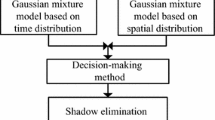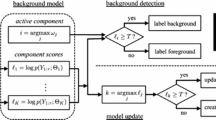Abstract
Foreground segmentation of moving regions in image sequences is a fundamental step in many vision systems including automated video surveillance, human-machine interface, and optical motion capture. Many models have been introduced to deal with the problems of modeling the background and detecting the moving objects in the scene. One of the successful solutions to these problems is the use of the well-known adaptive Gaussian mixture model. However, this method suffers from some drawbacks. Modeling the background using the Gaussian mixture implies the assumption that the background and foreground distributions are Gaussians which is not always the case for most environments. In addition, it is unable to distinguish between moving shadows and moving objects. In this paper, we try to overcome these problem using a mixture of asymmetric Gaussians to enhance the robustness and flexibility of mixture modeling, and a shadow detection scheme to remove unwanted shadows from the scene. Furthermore, we apply this method to real image sequences of both indoor and outdoor scenes. The results of comparing our method to different state of the art background subtraction methods show the efficiency of our model for real-time segmentation.








Similar content being viewed by others
References
Tavakkoli, A., Nicolescu, M., Bebis, G., Nicolescu, M.: Non-parametric statistical background modeling for efficient foreground region detection. Mach. Vis. Appl. 7(2), 1–15 (2009)
Farcas, D., Marghes, C., Bouwmans, T.: Background subtraction via incremental maximum margin criterion: a discriminative subspace approach. Mach. Vis. Appl. 23(6), 1083–1101 (2012)
Cheng, J., Yang, J., Zhou, Y., Cui, Y.: Flexible background mixture models for foreground segmentation. Image Vis. Comput. 24(5), 473–482 (2006)
Abbott, R.G., Williams, L.R.: Multiple target tracking with lazy background subtraction and connected components analysis. Mach. Vis. Appl. 20(2), 93–101 (2009)
Fuentes, L.M., Velastin, S.A.: People tracking in surveillance applications. Image Vis. Comput. 24(11), 1165–1171 (2006)
Tian, Y.L., Senior, A., Lu, M.: Robust and efficient foreground analysis in complex surveillance videos. Mach. Vis. Appl. 23(5), 967–983 (2012)
Mittal, A., Paragios, N.: Motion-based background subtraction using adaptive kernel density estimation. In: IEEE Computer Society Conference on Computer Vision and Pattern Recognition (CVPR), pp. 302–309 (2004)
Ren, Y., Chua, C.-S., Ho, Y.-K.: Motion detection with nonstationary background. Mach. Vis. Appl. 13(332–343), 93–101 (2003)
Or, S-H., Wong, Kin-H., Lee, K-S., Lao, T-K.: Panoramic video segmentation using color mixture models. In: The15th International Conference on Pattern Recognition (ICPR), Vol. 3, pp. 387–390 (2000)
El Baf, F., Bouwmans, T., Vachon, B.: Comparison of background subtraction methods for a multimedia learning space. In: The International Conference on Signal Processing and Multimedia Applications (SIGMAP), pp. 153–158 (2007)
Bouwmans, T., El Baf, F., Vachon, B.: Background modeling using mixture of gaussians for foreground detection: a survey. Recent Pat. Comput. Sci. 1(3), 219–237 (2008)
Stauffer, C., Grimson, W.E.L.: Adaptive background mixture models for real-time tracking. In: IEEE Computer Society Conference on Computer Vision and Pattern Recognition (CVPR), pp. 252–258 (1999)
Stauffer, C., Grimson, W.E.L.: Learning patterns of activity using real-time tracking. IEEE Trans. Pattern Anal. Mach. Intell. 22(8), 747–757 (2000)
Zivkovic, Z.: Improved adaptive Gaussian mixture model for background subtraction. In: The 17th International Conference on Pattern Recognition (ICPR), pp. 28–31 (2004)
Peng, A., Pieczynski, W.: Adaptive mixture estimation and unsupervised local Bayesian image segmentation. Graph. Models Image Process. 57(5), 389–399 (1995)
Friedman, N., Russell, S.: Image segmentation in video sequences: a probabilistic approach. In: The Thirteenth Conference on Uncertainty in Artificial Intelligence (UAI), pp. 1–3 (1997)
Lee, D.-S.: Effective Gaussian mixture learning for video background subtraction. IEEE Trans. Pattern Anal. Mach. Intell. 27(5), 827–832 (2005)
Wang, D., Xie, W., Pei, J., Lu, Z.: Moving area detection based on estimation of static background. J. Inf. Comput. Sci. 2(1), 129–134 (2005)
Allili, M.S., Bouguila, N., Ziou, D.: Finite general gaussian mixture modeling and application to image and video foreground segmentation. J. Electron. Imaging 17(1), 1–13 (2008)
Elguebaly, T., Bouguila, N.: Bayesian learning of finite generalized gaussian mixture models on images. Signal Process. 91(4), 801–820 (2011)
Elguebaly, T., Bouguila, N.: A nonparametric Bayesian approach for enhanced pedestrian detection and foreground segmentation. In: IEEE computer society conference on computer vision and pattern recognition workshops (CVPRW), pp. 21–26 (2011)
Akaike, H.: A new look at the statistical model identification. IEEE Trans. Autom. Control 19(6), 716–723 (1974)
Rissanen, J.: Modeling by shortest data description. Automatica 14, 465–471 (1987)
McLachlan, G.J., Peel, D.: Finite Mixture Models. Wiley, New York (2000)
Bouguila, N., Ziou, D.: A Dirichlet process mixture of generalized Dirichlet distributions for proportional data modeling. IEEE Trans. Neural Netw. 21(1), 107–122 (2010)
Wallace, C.S., Boulton, D.M.: An information measure for classification. Comput. J. 11(2), 195–209 (1968)
Kato, T., Omachi, S., Aso, H.: Asymmetric gaussian and its application to pattern recognition. In: The Joint IAPR International Workshop on Structural, Syntactic, and Statistical Pattern Recognition (SSPR), pp. 405–413 (2002)
Baxter, R.A., Olivier, J.J.: Finding overlapping components with MML. Stat. Comput. 10(1), 5–16 (2000)
Grimson, W.E.L., Stauffer, C., Romano, R., Lee, L.: Using adaptive tracking to classify and monitor activities in a site. In: IEEE Computer Society Conference on Computer Vision and Pattern Recognition (CVPR), pp. 22–29 (1998)
Cucchiara, R., Grana, C., Piccardi, M., Prati, A., Sirotti, S.: Improving shadow suppression in moving object detection with HSV color information. In: IEEE Intelligent Transportation Systems, pp. 334–339 (2001)
Schreer, O., Feldmann, I., Goelz, U., Kauff, P.: Fast and robust shadow detection in videoconference applications. In: Fourth IEEE International Symposium on Video/Image Processing and Multimedia Communications, pp. 371–375 (2002)
Salvador, E., Cavallaro, A., Ebrahimi, T.: Cast shadow segmentation using invariant color features. Comput. Vis. Image Underst. 95(2), 238–259 (2004)
Horprasert, T., Hardwood, D., Davis, L.S.: A statistical approach for real-time robust background subtraction and shadow detection. In: IEEE International Conference on Computer Vision, pp. 1–19 (1999)
Zhang, SW., Fang, X. Z., Yang, X.K.: Moving cast shadows detection using ratio edge. IEEE Trans. Multimed. 9(6):1202–1214 (2007)
Choi, J.M., Yoo, Y.J., Choi, J.Y.: Adaptive shadow estimator for removing shadow of moving object. Comput. Vis. Image Underst. 114(9), 1017–1029 (2010)
Finlayson, G.D., Hordley, S.D., Lu, C., Drew, M.S.: On the removal of shadows from images. IEEE Trans. Pattern Anal. Mach. Intell. 28(1), 5968 (2006)
Kaewtrakulpong, P., Bowden, R.: An improved adaptive background mixture model for realtime tracking with shadow detection. In: Workshop on Advanced Video Based Surveillance Systems, pp. 1–5 (2001)
Martel-Brisson, N., Zaccarin, A.: Learning and removing cast shadows through a multidistribution approach. IEEE Trans. Pattern Anal. Mach. Intell. 29(7), 1133–1146 (2007)
Liu, Z., Huang, K., Tan, T., Wang, L.: Cast shadow removal combining local and global features. In: IEEE Computer Society Conference on Computer Vision and Pattern Recognition (CVPR), p. 18 (2007)
Goyette, N., Jodoin, P.-M., Porikli, F., Konrad, J., Ishwar, P.: changedetection.net: a new change detection benchmark dataset. In: IEEE Computer Society Conference on Computer Vision and Pattern Recognition Workshops (CVPRW), pp. 1–8 (2012)
Evangelio, R.H., Patzold, M., Sikora, T.: Splitting gaussians in mixture models. In: IEEE Ninth International Conference on Advanced Video and Signal-Based Surveillance, pp. 300–305 (2012)
Elgammal, A., Harwood, D., Davis, L.: Non-parametric model for background subtraction. In: The 6th European Conference on Computer Vision (ECCV), pp. 751–767 (2000)
Nonaka, Y., Shimada, A., Nagahara, H., Taniguchi, R.: Evaluation report of integrated background modeling based on spatio-temporal features. In: IEEE Computer Society Conference on Computer Vision and Pattern Recognition Workshops (CVPRW), pp. 9–14 (2012)
Maddalena, L., Petrosino, A.: A self-organizing approach to background subtraction for visual surveillance application. IEEE Trans. Image Process. 17(7), 1168–1177 (2008)
Acknowledgments
The completion of this research was made possible, thanks to the Natural Sciences and Engineering Research Council of Canada (NSERC). The author would like to thank the anonymous referees and the associate editor for their helpful comments.
Author information
Authors and Affiliations
Corresponding author
Appendices
Appendix A
In this Appendix, we calculate the derivative of \(\frac{\partial L(\varTheta ,Z,{\mathcal {X}})}{\partial \mu _{jk}}, \frac{\partial L(\varTheta ,Z,{\mathcal {X}})}{\partial \sigma _{l_{jk}}}, \frac{\partial L(\varTheta ,Z,{\mathcal {X}})}{\partial \sigma _{r_{jk}}}, \frac{\partial ^2 L(\varTheta ,Z,{\mathcal {X}})}{\partial \sigma _{l_{jk}}^{2}} \), and \(\frac{\partial ^2 L(\varTheta ,Z,{\mathcal {X}})}{\partial \sigma _{r_{jk}}^{2}}\) used in the EM algorithm and background subtraction.
Appendix B
In this Appendix, we develop the solutions for Eqs. (24, 25, 26) used in the MML algorithm
Rights and permissions
About this article
Cite this article
Elguebaly, T., Bouguila, N. Background subtraction using finite mixtures of asymmetric Gaussian distributions and shadow detection. Machine Vision and Applications 25, 1145–1162 (2014). https://doi.org/10.1007/s00138-013-0568-z
Received:
Revised:
Accepted:
Published:
Issue Date:
DOI: https://doi.org/10.1007/s00138-013-0568-z




